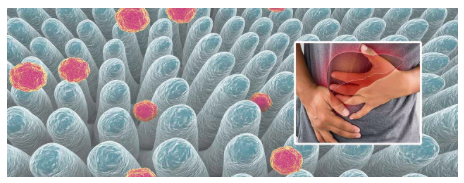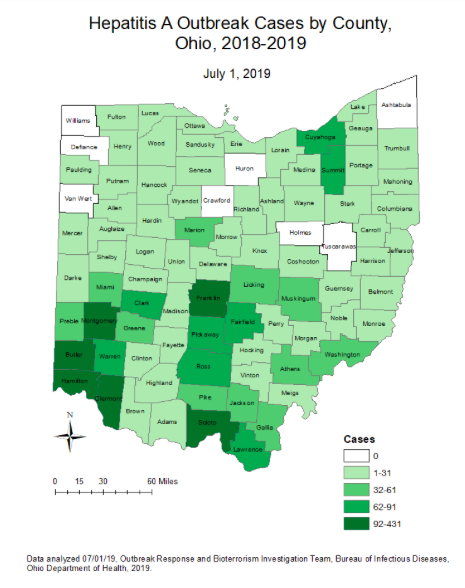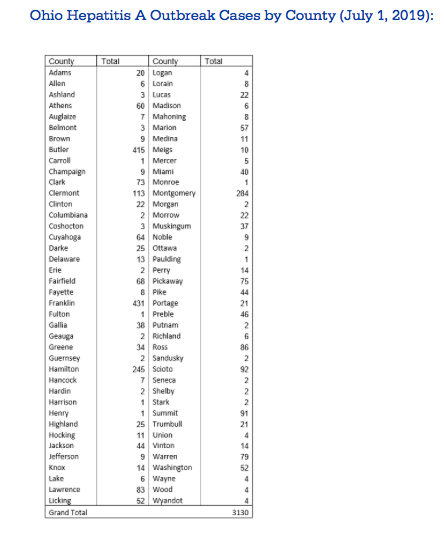Hepatitis A Statewide Community Outbreak
 The Ohio Department of Health (ODH) declared a statewide community outbreak in June 2018 after observing an increase in hepatitis A cases. Hepatitis A is a vaccine-preventable liver disease that usually spreads when a person ingests fecal matter - even in microscopic amounts - from contact with objects, food or drinks contaminated by the stool of an infected person. Hepatitis A can also be spread from close personal contact
The Ohio Department of Health (ODH) declared a statewide community outbreak in June 2018 after observing an increase in hepatitis A cases. Hepatitis A is a vaccine-preventable liver disease that usually spreads when a person ingests fecal matter - even in microscopic amounts - from contact with objects, food or drinks contaminated by the stool of an infected person. Hepatitis A can also be spread from close personal contact
with an infected person, such as through sex. The statewide community outbreak is spread through person-to-person contact.
In May 2019, the Centers for Disease Control and Prevention (CDC) provided an updated case definition resulting in an increase in the number of outbreak cases in Ohio. ODH and local health departments continue to investigate reported hepatitis A cases.
The high-risk populations for hepatitis A in this outbreak include:
- People who use drugs (injection or non-injection)
- People experiencing unstable housing or homelessness
- People who are currently or were recently incarcerated
- Men who have sex with men (MSM)
- People with chronic liver disease, including cirrhosis, hepatitis B, or hepatitis C
Symptoms of hepatitis A include fatigue, low appetite, stomach pain, nausea, clay-colored stools and jaundice. People with hepatitis A can experience mild illness lasting a few weeks to severe illness lasting several months.
People who believe that they are at high risk for hepatitis A infection should contact their healthcare provider or local health department for information about vaccination. People who know that they have been exposed to someone with hepatitis A should contact their healthcare provider or local health department to discuss post-exposure vaccination options. Individuals who experience symptoms of hepatitis A should contact their healthcare provider. Click here to find a local health department in Ohio.
Outbreak Case Statistics
(Information will updated each Monday by 2:00 PM)

Ohio Hepatitis A Outbreak Cases by County (July 1, 2019):

Hepatitis A Outbreak Summary (July 1, 2019):
- Number of cases: 3130
- Illness onset range: 01/05/2018 – 06/25/2019
- Age range: 1-89 years
- Gender: 61% male
- Number of hospitalizations: 1881 (60%)
- Number of deaths: 13
- Number of counties with cases: 80 (91%)
Ohio Hepatitis A Outbreak Case Definition:
CLINICAL CRITERIA
An acute illness with a discrete onset since January 1, 2018 of any sign or symptom consistent with acute viral hepatitis (e.g., fever, headache, malaise, anorexia, nausea, vomiting, diarrhea and abdominal pain),
AND
Jaundice or elevated total bilirubin levels ≥3.0 mg/dL, OR
Elevated serum alanine aminotransferase (ALT) levels (>200 IU/L)
AND
The absence of a more likely diagnosis
LABORATORY CRITERIA
Immunoglobulin M (IgM) antibody to hepatitis A virus (anti-HAV) positive, OR
Nucleic acid amplification test (NAAT; such as PCR or genotyping) for hepatitis A virus RNA positive
CONFIRMED CASE
A case that meets the clinical criteria and is IgM anti-HAV positive, OR
A case that has hepatitis A virus RNA detected by NAAT (such as PCR or genotyping), OR
A case that meets the clinical criteria and occurs in a person who has an epidemiologic link (household contact, drug partner, or sexual contact) with a laboratory-confirmed hepatitis A case 15–50 days prior to onset of symptoms
EXCLUSIONS
A case will be excluded if any of the following conditions apply:
In the absence of known risk factors (injection or non-injection drug use, men who have sex with men, homelessness, or incarceration), any case that occurs in a patient who reports travel to a country or U.S. territory with endemic hepatitis A during the 15–50 days before symptom onset, OR
Any case that is linked to a foodborne outbreak by related sequencing, OR
In the absence of known risk factors (injection or non-injection drug use, men who have sex with men, homelessness, or incarceration), any case that is epi-linked to a foodborne outbreak, OR
Any case with a specimen collected within four weeks of symptom onset that is negative for HAV RNA
For more information, please call the Ohio Department of Health Bureau of Infectious Diseases at (614) 995-5599.









